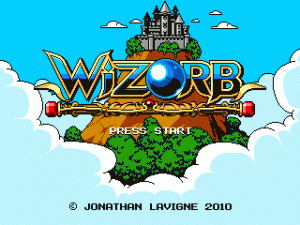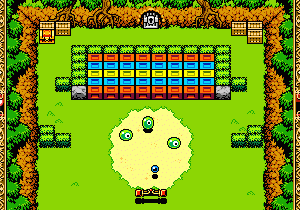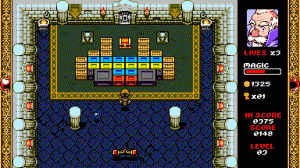Given the current industry climate, claiming a game is “a breath of fresh air” feels like an overused expression. More people are creating independent video games now than ever before, sharing their passion for the medium and introducing new ideas and insightful variations to routine genre themes. Wizorb, a Breakout-style arcade game from indie studio Tribute Games, is no such marriage of clever concepts or daring foray into uncharted territory. Although there are some light RPG trimmings added to the familiar block-breaking action, the basic three-part formula has evolved little since Arkanoid: there are blocks, there is a ball, and a pervading nihilistic credo to eliminate all of the former using the latter.
Instead, Wizorb’s fresh air comes from the fact that every aspect has been crafted to fulfill the purest classic gameplay experience possible. Here is the naked art of the arcade game elevated to the highest level – the challenge of a player’s skills in an arena of singing equations and mathematical variables masked behind attractive, colorful pixels.
As soon as the title screen boots, the graphics immediately dazzle. Rendered completely in an 8-bit style with an enhanced 128 color palette, the game looks like the most rose-tinted memories of childhood NES games. Surfaces shimmer, animations run fluidly and never look blocky, and effects always resolve in an engaging way using fades and extra frames instead of simply disappearing. Jonathan Lavigne, also responsible for the look of last year’s Scott Pilgrim Vs. The World: The Game, utilizes every last pixel to conjure memories of wood-paneled dens or basements where gamers once worshipped at the humble grey altar of the NES.
The richness of the experience is in a large part due to the myriad of tiny details that enhance the menu and game design. It’s one of the rare games that proclaims “Press Start to Play” on the title screen and honestly means it; a callback to a time when “Start” and “Fire” might be the only two buttons available. This philosophy extends to every element of the game’s design: highlighted text shimmers attractively, the ball ricochets off hard surfaces with a satisfying digital “ting!” the paddle itself bounces back from the impact of the ball and the controller emits a faint, pleasing rumble. As it bounces around the stage vaporizing blocks and smashing stones, crates and bushes, the ball is imbued with an artificial heft that embodies each loss with a palpable impact. The portrait of the eponymous ‘Wiz’ (in true retro fashion, only identified with a proper name in the short text scene following completion of the game) in the upper right corner of the screen imitates the same disappointed, eyes-clenched “ooohhhh” face instinctively made by the player and observing audience as the ball sails past the paddle into the abyss below. The small staff at Tribute Games has tapped into the most primal language of what makes this style of game satisfying and weaves it all together into a satisfying tapestry.
Each addition to the Breakout formula serves a distinct purpose to make the game more fun and avoid the previous failings of the genre. For example: we all know getting the power-up that lets you shoot lasers in Arkanoid is awesome. Everyone also knows the feeling of defeat that comes with a bungled death resulting in the loss of the laser power-up. Much like losing the remote bombs in Bomberman or the spread gun in Contra, it makes playing the “regular” game again a chore. Instead of relegating useful gameplay modifications to temporary power-ups, Wizorb always grants access to an arsenal of magic abilities. One shoots a fireball to destroy that last pesky brick; another allows temporary control or teleportation of the ball to a specific zone on the board. Each ability takes a percentage of the magic bar depending on how useful it is, but collecting potions or bouncing the ball a certain number of times without hitting anything will refill the meter. Because of this simple inclusion, a player never finds themselves in a situation that feels unwinnable. Difficult perhaps, but never completely hopeless.
Other additions include falling gold coins and gems that can be stockpiled and used to buy temporary bonuses such as a longer paddle or multiple balls at shops scattered through each world. Or, if you prefer, you can funnel your gold stash into a destroyed village to slowly rebuild each building and earn rewards from the grateful residents. Treasure chests hold either keys to locked doors where bonus rounds await or terrible curses that temporarily cripple your paddle if mistakenly collected. Each world is capped with a boss battle that, while never quite as challenging as the regular levels, will add a little twist to accompany the beautifully-animated extra-large boss sprites. Once again, the love put into the graphics is inspiring – each boss has a unique death animation that makes getting that final hit so much more satisfying. My favorite: a muscle-bound werewolf howls in defeat and turns into a regular, confused-looking puppy… then explodes.
Finally, extra lives are imbued with a value not seen since the earliest days of the arcade. The loss of each ball is inevitable – every bounce on the screen adds a little bit of speed and unpredictability that will eventually overwhelm you. The little tune that plays when you catch a falling 1-up heart becomes the sweetest possible melody. There is a reason every gamer can recognize the 1-up sound effect from Super Mario Brothers: it used to actually represent something. It’s a vestigial relic from a time where an extra “x1” at the top of the screen represented a little more value out of each quarter dropped in the slot, a little more time you’d be allowed to spend in a new and exciting digital world. Where so many other games reward you with extra lives to the point where they become utterly meaningless (see every post-SMB3 Nintendo game), Wizorb never failed to send me scrambling as soon as those hearts appeared.
You might be tempted to put this game on the back burner due to the upcoming deluge of big name sequels, promising to save your purchase for leaner times to come. Believe me, I’m just as excited to dive head first into upcoming holiday blockbusters. But perhaps the release window of Wizorb is an advantage. In our current age of obsessive unlockables, achievements, and stat tracking, it’s lovely to play a game simply for the unfettered joy of the experience. To attain a high score not just to topple a friend on a leaderboard or Facebook, but to enjoy the feeling of your skills improving, becoming a little bit faster with every play.
Your mileage may vary depending on which era you first picked up a controller, but playing Wizorb reminded me why I love the medium so much in the first place. Instead of undermining its big-budget brethren or sparking a yearning for a simpler time, it made me think about the “why” and “how” of game design and the common language we all speak as gamers. We’ve come a long way since the first digital paddle hit the first digital ball, but the resulting echo is still resonating through the ages.
Release Date: September 28, 2011
Developer: Tribute Games
Price: 240 Microsoft Points ($3.00)
Buy Now: http://marketplace.xbox.com/en-US/Product/Wizorb/66acd000-77fe-1000-9115-d80258550981
VentureBeat's mission is to be a digital town square for technical decision-makers to gain knowledge about transformative enterprise technology and transact. Learn More



